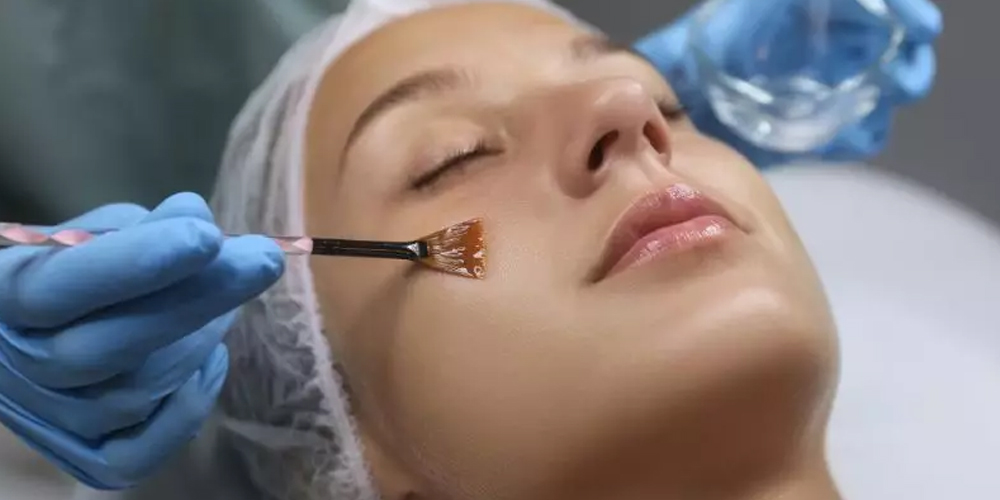
WHAT IS CHEMICAL PEELING TREATMENT?
Chemical peel treatment or chemexfoliation is a technique where strong chemical agents (in the right concentrations), usually acidic in nature, are applied over the skin with the desired action of removing the top layer and hence replacing it with the underlying smoother skin. It is therefore also called a skin peeling treatment. They are most commonly done over the face, neck or hands Skin peeling chemical agents can be categorized based upon the depth at which they act. They can be superficial peels, acting on the outermost layer of the skin, medium depth peels or deep peels acting up to the middle layers of the skin. A general thumb rule could be that peels that act deeper have stronger action for the indications they are used for. However, this may not always be the case. We provide the details of the various chemical peel treatments, to help you understand them. Your dermatologist will ultimately be the best judge of which chemical peel treatment is best for you. The various kinds of chemical peels offered by our clinics in Mumbai include, but are not limited to: Mandelic acid peel: This is an alpha hydroxy acid (AHA) based peel that acts superficially. It is suitable for all skin types and skin tones. It is derived from bitter almonds. The indications it helps with includes acne, fine lines, melasma and other types of pigmentation. Salicylic acid peel: This type includes beta hydroxy acid (BHA) chemical peels that act superficially. It is not ideal for sensitive skin. It is derived from willow bark and wintergreen leaves. The major indication it is used for is acne and oiliness (comedogenicity). Lactic acid peel: This is again an AHA peel that acts superficially. Stronger formulas may also act on medium depth. It is derived naturally from milk. It works well for sensitive skin in milder concentrations. It may not be ideal for some darker skin tones. It helps with ages spots and hyperpigmentation. Glycolic acid peel: glycolic acid is an AHA peel that is derived from sugarcane. It has anti-inflammatory and anti-oxidant properties. Although mild concentrations act superficially, in higher concentration they act on the deeper layers of skin. It helps with acne, acne scars, stretch marks, hyperpigmentation including melasma, age spots and sun spots. TCA peel: Trichloroacetic acid peels can be superficial or deep acting depending upon the strength an concentration. There are variants like the cross TCA peel also available. It is helpful in acne, acne scars, anti aging and pigmentation. Jessner’s peel: These type of chemical peels are most commonly used as a peel acting at medium depth. It is a mixture of lactic acid, salicylic acid and resorcinol in an ethanol solution. It helps with pigmentation, age spots, an even skin tone, fine lines and scars. Yellow peel: This chemical peel improves the oxygen and nutrient supply to the skin. It contains three ingredients, phytic acid, kojic acid and azelaic acid. Indications include acne scars, pigmentation, fine lines on the skin. Azelaic acid peel: Azelaic acid is derived from food grains such as wheat, barley and rye. It is suitable for most skin types. It helps with open pores, acne, scars, pigmentation and rosacea. Kojic acid peel: Kojic acid is a by-product of fermentation by fungi. These chemical peels act in inhibiting tyrosinase that helps in the production of melanin. They hence tend to have a skin whitening effect. They also help with sun spots and age related damage. Phenol peel: These are deep acting chemical peels which are strong in concentration and are helpful for age spots, pigmentation, scars and fine lines. It is recommended to get chemical peels only in a clinical setting under the supervision of a dermatologist given the possible side effects if not done by a medical professional.
HOW EFFECTIVE IS CHEMICAL PEELING FOR
What results can you expect from Chemical Peeling treatment? What factors that impact the efficacy of Chemical Peeling? Chemexfoliation can be used to improve a wide variety of indications which include, but are not limited to:
- Acne
- Acne scars
- Sun spots
- Pigmentation or hyperpigmentation
- Wrinkles and fine lines
- Redness
- Other scars
- Melasma
- General glow and skin lightening
- Rosacea
- Open pores
- Improved texture
- Reducing Oiliness
- Freckles